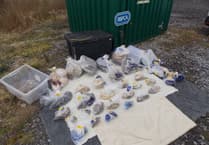A FREE virtual lecture will be held this week exploring a “mysterious” ship wreck site, discovered by a Talybont man off the Welsh coast.
The Bronze Bell wreck site was discovered by divers in 1978 off the Meirionnydd coast, after a local man, Geraint Jones, had started finding artefacts washed up on the beach.
The name of the ship is unknown but has been re-named after a bronze bell, dated 1677, was found when the wreck was first discovered.
In 2021, MSDS Marine were commissioned by the CHERISH project to undertake a programme of diving on the Bronze Bell protected wreck site. The wreck was last visited by an archaeological contractor in 2004. But this visit was the first to assess the impact of climate change on the wreck.
On 17 February, at 5pm, director and project manager for MSDS, Alison James, will give an update on the diving fieldwork and discuss the findings, in a virtual Zoom lecture hosted by the Royal Commission on the Ancient and Historical Monuments of Wales (RCAHMW).
During a podcast, recorded in November 2021, Alison said: “The wreck has discovered by a local man, Geraint Jones, back in the 70s.
“He regularly metal detected on the beach with his brother and one day they uncovered a small metal medallion.
“He researched it and basically found other example and could see that it was an early 18th century date. That led to him going to the beach more often, where he started to see wreck material regularly washing up.
“He started mapping it to see if he could work out where it was all coming from. To cut a long story short, he subsequently learnt to dive and got involved with some local divers from the KSN group, who then went out and put everything he had worked out in his head into theory.
“They dived on the site and located the wreck in 1978.”
The site, which got its name from the bronze bell divers reportedly found on their very first dive, was subsequently designed under the Protection of Wrecks Act.
“They continued to work on the wreck, they recovered material and even taught themselves conservation skills to conserve the finds they brought to the surface.
“We don’t really know the name of the wreck, its got a large cargo of Carrara marble blocks on it, and others finds have led archaeologists to believe the wreck is early 18th century and most probably Genoese in origin.”
Alison added: “It is one of just six protected wreck sites in Welsh waters so I think you can say its fairly significant.”
If you would like to register for the free Zoom lecture, please go to https://ti.to/digital-past/bronze-bell-wreck.
CHERISH (Climate, Heritage and Environments of Reefs, Islands, and Headlands) is a 6-year European-funded Ireland-Wales project, bringing together four partners, including the RCAHMW and Aberystwyth University’s Department of Geography and Earth Sciences, and Geological Survey, Ireland. The project began in January 2017 and will run until June 2023.




